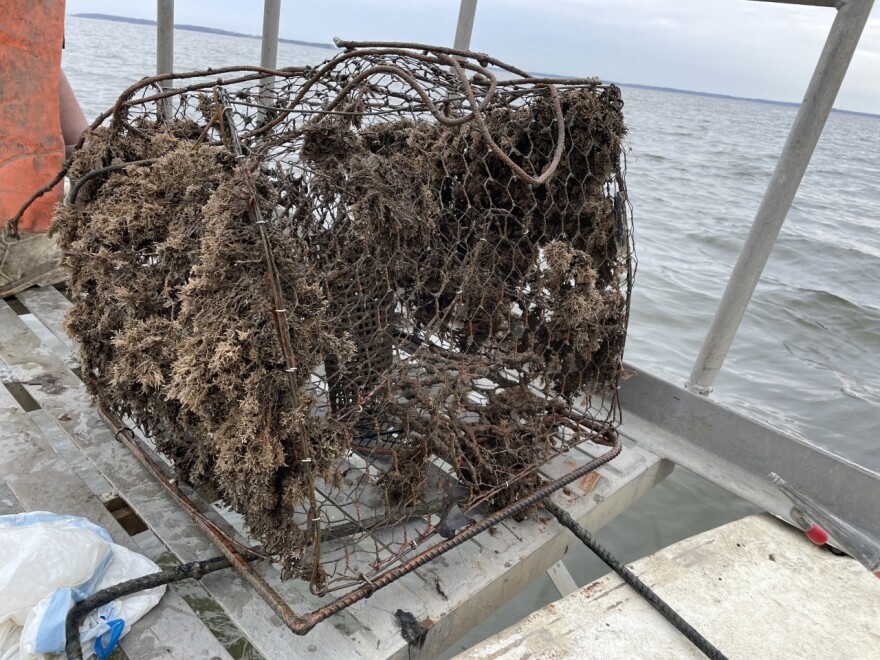Chesapeake Bay watermen lose thousands of crab pots every year. Storms drag them away or they are accidentally cut loose by boat propellers. They settle on the bottom, continuing to trap crabs and other aquatic species and essentially competing with commercial and recreational crabbing and fishing for a limited supply.
The National Oceanic and Atmospheric Administration (NOAA) Chesapeake Bay office estimates that watermen deploy more than 250,000 crab pots a day throughout the season. And a recent study by the Virginia Institute of Marine Science (VIMS) found that up to 150,000 of those pots are lost annually, becoming what are known as “ghost pots.”
Kirk Havens, director of the Center for Coastal Resources Management at VIMS, says that’s not only a loss of an expensive pot, but a loss of crabs and other fish that get trapped and die in those pots. He calls it a “gear efficiency problem.”

“That ghost gear is competing against the active gear that the crabber is utilizing in fishing and taking crabs from that," he said.
NOAA’s scientists estimated removing ghost pots over six years could lead to more than $30 million in additional catch for watermen.
Havens said Maryland and Virginia had robust programs to clean up ghost pots from about 2008 to 2012 using federal grants. But that money dried up and the programs have become “episodic” at best, he added.
“And once the funding went away, then it was kind of like, well, can we get funding from this organization?” he queried. “It all depends on where you could, if you could, actually get the funding.”
Baltimore County just finished running one of those “episodic” programs for the second year. The county’s Department of Environmental Protection and Sustainability issued a $150,000 grant to Annapolis-based Oyster Recovery Partnership to hire 15 local watermen to clear at least some of the thousands of ghost pots from county waters.

Capt. Bob Wiley, who operates out of Bowley’s Quarters near the mouth of Middle River, was among those watermen who recently spent two weeks fishing ghost pots from about 3,000 acres of bay bottom just north of Hart Miller Island.
He says the search provides work in the off season.
“Basically, it's like the slow time of the year,” Wiley said. “We get ready, get ready to go crabbing here in April.”
On a recent slate gray morning Wiley and his son Matthew dragged another “ghost” pot caked with mud from the bottom and left it hanging just off the stern of his workboat, Dragon Lady.
Wiley gunned the engine and dragged the pot through the water, trailing a plume of black mud, before he hauled it aboard.

Most of the pots they pulled up were thick with mud; one contained a large, dead crab, two sunfish and a yellow perch that were still alive. They threw them back.
Wiley and the other watermen find the pots using “GPS coordinates mapped out right here,” he says, tapping a navigational chart on a computer screen in the boat’s cabin.
Jennifer Walters, a coastal resource scientist with ORP, explains they mapped the pots using side scan sonar.
“So, when they go out and take the side scan imagery of the bottom, they're detecting anything that's hard,” she said. “And they can actually see the square frame of the pot on the bottom. But we just basically made all of those pots from the side scan imagery of the bottom into points.”
Those points appear as red dots on Wiley’s computer screen.
Walters says the watermen dragged more than 1,200 ghost pots from the water over two weeks.
The captains can keep pots that are in good condition and re-use them. The ones that are so badly damaged they can’t be salvaged are recycled for the metal. And any non-metal debris, such as lines, goes into a dumpster to be disposed of.

As Wiley lined up Dragon Lady for a pass at another pot, Matthew prepared the drag bar, a piece of apparatus about as long as the boat is wide with six lines evenly spaced along its length trailing below it. Each line has two sets of small grappling hooks.
Matt dropped the drag bar off the stern and let the line pay out, then looped the knotted end of it around a cleat on board.
“A lot of times we'll see one side of the drag hit and this knot will spin around,” he explained. “It hits a pot on the side, it'll spin it. And that's how we know we got a pot on there.”
Meanwhile, Capt. Bob has his eyes trained on the computer screen, which shows the boat passing over one of those red dots that represents a pot. But there’s no guarantee his gear will snag that pot.
“Sometimes you'll see that pot and you won't grab it,” he said. “You can't believe you didn't grab it. But you could turn right around and get it.”
And sometimes the pot is so deteriorated that the hook tears off only a piece of it. But this time, the knot spun off to port. The boat gave the slightest lurch. They had the pot. Capt. Bob and his son hauled the line in until the pot hung in the water off the stern. Now to get the mud out of it.












